Advertisements
Advertisements
Question
What is a solenoid?
Solution
A solenoid is a copper wire with a resistive coating coiled into a chain of loops. When an electric current flows through a solenoid, magnetic lines of force form in a pattern. Solenoid magnetic fields are similar to those created by bar magnets. A solenoid's open ends function as magnetic north and south poles, respectively.
APPEARS IN
RELATED QUESTIONS
Why does a current carrying, freely suspended solenoid rest along a particular direction?
State the direction in which current-carrying freely suspended solenoid rests
The figure shows a solenoid wound on a core of soft iron. Will the end A be a N pole or S pole when the current flows in the direction shown?

Draw a diagram to represent the magnetic field lines along the axis of a current carrying solenoid. Mark arrows to show the direction of current in the solenoid and the direction of magnetic field lines.
The following diagram shows a spiral coil wound on a hollow carboard tube AB. A magnetic compass is placed close to it. Current is switched on by closing the key.
- What will be the polarity at the ends A and B?
- How will the compass needle be affected? Give reason.
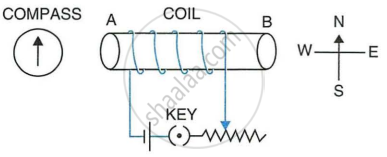
State two ways by which the magnetic field due to a current carrying solenoid can be made stronger.
What effect will there be on a magnetic compass when it is brought near a current carrying solenoid?
How is the magnetic field due to a solenoid carrying current affected if a soft iron bar is introduced inside the solenoid?
A current carrying solenoid behaves like a ______.
A current carrying solenoid when freely suspended, it always rests in ______ direction.
- What name is given to a cylindrical coil of diameter less than its length?
- If a piece of soft iron is placed inside the coil mentioned in part (a) and current is passed in the coil from a battery, what name is then given to the device so obtained?
- Give one use of the device mentioned in part (b).
Draw the pattern of magnetic field lines of a solenoid through which a steady current flows. What does the pattern of field lines inside the solenoid indicate?
Derive the expression for the heat produced due to a current ‘I’ flowing for a time interval ‘t’ through a resistor ‘R’ having a potential difference ‘V’ across its ends. With which name is the relation known? How much heat will an instrument of 12W produce in one minute if it is connected to a battery of 12V?
Draw magnetic field lines in and around a current-carrying straight solenoid.
The diagram shows a current-carrying coil passing through a cardboard sheet. Draw three magnetic lines of force on the board.
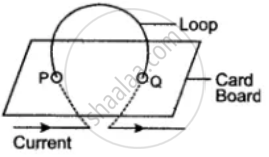
State two factors on which magnitude of magnetic field at the centre depends.
Sketch the lines of force of the magnetic field of a solenoid. How does its field compare with that of a bar magnet?
The adjacent diagram shows a small magnet placed near a solenoid. State whether the magnet is attracted or repelled, as the switch is pressed. Give a reason.
What is a solenoid? Why do we usually keep its diameter small in comparison to its length?
The pattern of the magnetic field produced by the straight current-carrying conducting wire is ____________.
The factors on which one magnetic field strength is produced by current-carrying solenoids depends are
The diagram below shows a magnet moved near a coil along its axis. Which of the diagram shows correct flow of current during this motion?
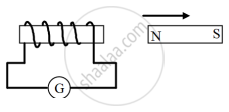
What does the divergence of magnetic field lines near the ends of a current carrying straight solenoid indicate?
The diagram below shows an insulated copper wire wound around a hollow cardboard cylindrical tube. Answer the questions that follow:
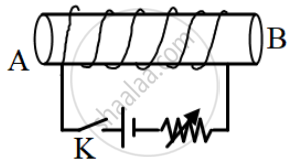
- What are the magnetic poles at A and B when the key K is closed?
- State two ways to increase the strength of the magnetic field in this coil without changing the coil.
- If we place a soft iron bar at the centre of the hollow cardboard and replace the DC source with an AC source then will it attract small iron pins toward itself when the current is flowing through the coil?
A circuit contains a battery, a variable resistor and a solenoid. The figure below shows the magnetic field pattern produced by the current in the solenoid.

- State how the magnetic field pattern indicates regions where the magnetic field is stronger.
- What happens to the magnetic field when the current in the circuit is reversed?
Ansari Sir was demonstrating an experiment in his class with the setup as shown in the figure below.

A magnet is attached to a spring. The magnet can go in and out of the stationary coil. He lifted the Magnet and released it to make it oscillate through the coil.
Based on your understanding of the phenomenon, answer the following question.
Is there any difference in the observations in the galvanometer when the Magnet swings in and then out of the stationary coil? Justify your answer.
When does a solenoid behave as a magnet? Draw the pattern of the magnetic field produced inside it showing the directions of the magnetic field lines.
For the current carrying solenoid as shown, draw magnetic field lines and give reason to explain that out of the three points A, B and C, at which point the field strength is maximum and at which point it is minimum?

Refer to the image below and state how the magnetic field pattern indicates regions where the magnetic field is stronger outside the magnet. What happens to the magnetic field when the current in the circuit is reversed?
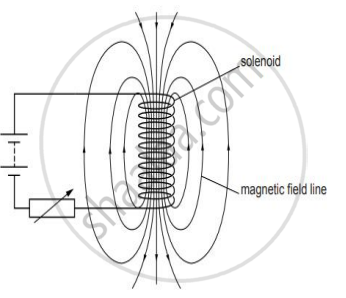
How is a solenoid prepared?
Differentiate between a circular coil and a solenoid.
Draw a neat diagram of a solenoid and name its various components.
